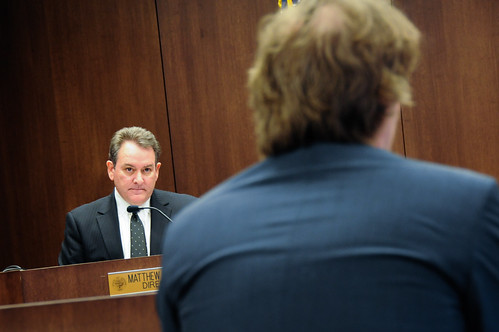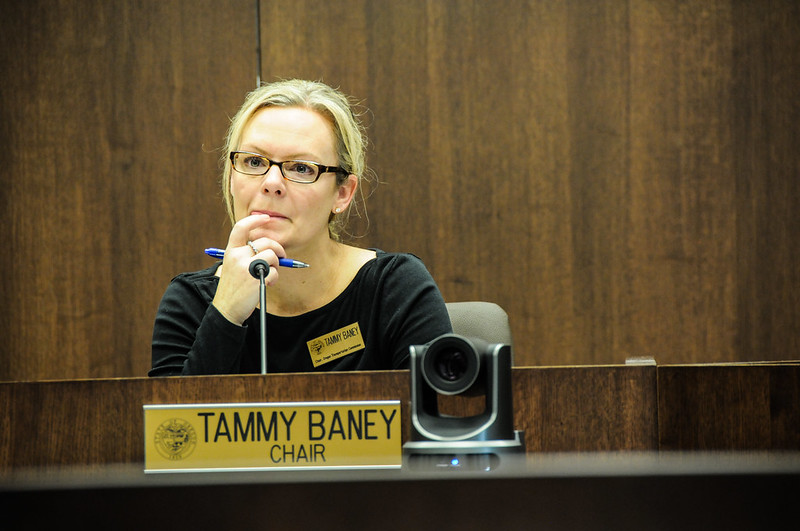
(Photos: J. Maus/BikePortland)
Oregon Department of Transportation Director Matt Garrett sat silenty for nearly two hours today while members of the Oregon Transportation Commission (OTC, ODOT’s governing body) probed deeper into an audit of the agency he has led since 2005.
ODOT got solid marks from auditors in some categories — like organizational culture and building and maintaining highways. But auditors also found the agency needs a clearer short-term plan and more effective coordination with its governing body, the OTC.
“[ODOT is] a very capable organization… However, the timing I think is right for a step back, around, how do we actually manage given the changing nature of the challenges we’ve talked about?”
— Tyler Duvall, McKinsey & Company
The OTC called the special meeting at ODOT headquarters in Salem to hear from Tyler Duvall of McKinsey & Company, the firm hired by the Department of Administrative Services to assess how ODOT is managed. The $1 million, 65-page audit (PDF) is meant to reassure lawmakers and the public that ODOT is up to the task of handling a massive transportation package that has been named a top priority by Governor Kate Brown. The legislative session started yesterday and the framework of a deal is already being hashed out.
The last time the legislature debated such a package, in 2015, many people pinned its demise on Garrett’s lack of transparency about a key metric (greenhouse gas emissions) in the bill. Several lawmakers called for Garrett’s resignation following that fiasco. Then just a few weeks ago OTC Chair Tammy Baney shocked Capitol-watchers when she sent a letter to Governor Brown asking for greater oversight of ODOT — a move many interpreted as a vote of “no confidence” in the agency.
Advertisement
And it’s worth remembering that Baney became OTC Chair two years ago after the former chair, Catherine Mater, was relieved of her duties by then-Governor Kitzhaber, according to the Portland Tribune, “after questioning a project that she concluded showed signs of fraud.”
In the context of recent events and future debates, this “strategic misalignment” and what appears to be an emerging power struggle between ODOT and the OTC is one of the most important issues the audit has helped to define.
“The goal should be that you as a body speaks with a voice that is clear so the agency [ODOT] can take that direction and run with it,” Duvall said today. “In absence of that alignment, you express things in more generalities.” Duvall expressed that the lack of alignment between ODOT and the OTC manifests publicly and then flows through the entire bureaucracy. “That misalignment is not getting resolved in a unifed way right now,” he said.
Here’s an excerpt on this from the audit:
…there is a strategic misalignment within the OTC and between the OTC and ODOT that bespeaks a lack of consistent communication and partnership… When asked in interviews about their top three priorities, commissioners did not have a uniform answer… and many did not align with ODOT’s five stated goals.
…
[OTC] commissioners and ODOT leaders are not aligned around a consistent vision of agency priorities.
The audit also found that the OTC’s charter is too vague and its five members often feel like they don’t have the information they need to make informed decisions. Here’s a relevant excerpt from the audit:
OTC’s role, responsibilities, and decision-making process are ambiguous and inconsistent. OTC does not utilize committees, does not conduct internal assessments of the commission’s progress against its objectives, and does not conduct performance assessments of the ODOT director.
“You have my word, this is just the beginning.”
— Tammy Baney, OTC Chair
This disconnect between ODOT and the OTC is a big deal. If the governing body that ostensibly “establishes state transportation policy” isn’t even on the same page as ODOT, there’s no way we can effectively implement existing plans or execute new policies. (Not to mention the fact that the audit also revealed the OTC “reports only infrequent interaction with the Oregon State Legislature.”)
The findings Duvall presented today validate the concerns and ideas outlined by Baney in her letter to Governor Brown last month. In an interview today before the OTC meeting, Baney continued that change-oriented tone. “Now it’s about taking the findings [of the audit] and putting them into action,” she said.
After listening to the presentation today, Baney posed a question to Duvall with an aim to, “address the elephant in the room.” “In your professional opinion,” she wondered, “Where are we with the health of the organization? Does it give you pause in terms of how we fared [in the audit]?”
In response, Duvall praised ODOT, saying “has clear strengths” and is a “very capable organization.” But, he added, appearing to choose his words carefully, “the timing I think is right for a step back, around, how do we actually manage given the changing nature of the challenges we’ve talked about?”
At the end of today’s meeting, OTC member Paula Brown hinted that they’ll now work to figure out the nature and scope of potential changes. “This is just a jumping-off point” she said about the audit. “It can’t end here.” To which Baney replied, “You have my word, this is just the beginning.”
From here, the Department of Administrative Services will draft a set of official recommendations (in consultation with McKinsey) and plans to deliver them to Governor Brown, the OTC, and the Legislature by the end of February.
— Jonathan Maus: (503) 706-8804, @jonathan_maus on Twitter and jonathan@bikeportland.org
BikePortland is supported by the community (that means you!). Please become a subscriber or make a donation today.


